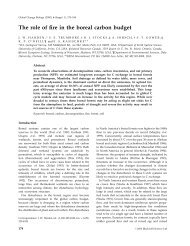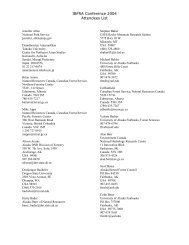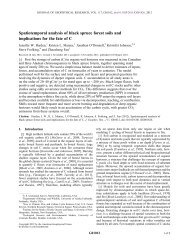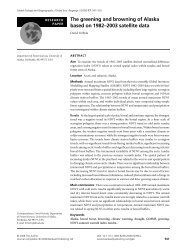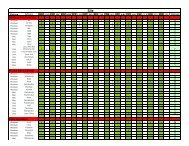Chapin, F.S., III, M.D. Robards, H.P. Huntington, J.F. Johnstone, S.F. ...
Chapin, F.S., III, M.D. Robards, H.P. Huntington, J.F. Johnstone, S.F. ...
Chapin, F.S., III, M.D. Robards, H.P. Huntington, J.F. Johnstone, S.F. ...
You also want an ePaper? Increase the reach of your titles
YUMPU automatically turns print PDFs into web optimized ePapers that Google loves.
F. S. <strong>Chapin</strong> et al., Directional Changes in Ecological Communities<br />
02/26/2007 07:26 AM<br />
climate (Lynch et al. 2002). This species supports the growth of an understory of evergreen shrubs and<br />
mosses, which together with black spruce are highly flammable (Van Cleve et al. 1991). The arrival of black<br />
spruce therefore coincided with a dramatic increase in fire frequency, which persists today (Lynch et al.<br />
2002). A continuation of recent high-latitude warming (Hinzman et al. 2005) could cause further increases in<br />
fire frequency and severity (Flannigan et al. 1998), perhaps increasing the proportion of deciduous forests on<br />
the landscape (<strong>Chapin</strong> et al. 2003, 2004). Arrival of new species could also initiate a change in fire regime<br />
and community composition. Lodgepole pine is actively migrating northwestward from western Canada to<br />
Alaska and grows well in experimental plantations in Alaska. The serotinous cones of lodgepole provide an<br />
abundant seed source after fire (<strong>Johnstone</strong> and <strong>Chapin</strong> 2003). Once established, lodgepole pine promotes fire<br />
through development of a flammable decay-resistant litter layer and a flammable forest structure. From a<br />
management perspective, a key outcome of this pattern is that systems may experience hidden changes in<br />
resilience that become apparent only when a disturbance occurs (fig. 2). Restoration ecologists often have a<br />
good understanding of the impact of different types of disturbance on subsequent community development,<br />
providing the expertise necessary to influence this source of uncertainty in community change.<br />
(63 kB)<br />
Figure 3: Three alternative successional trajectories that occur after fire in interior Alaska. Each row<br />
shows the temporal change in community composition (from left to right) after postfire recruitment.<br />
Thin arrows show the normal successional transitions. Thick arrows show the most likely postfire<br />
transition (to an early successional stage of the same successional trajectory). Dashed arrows show<br />
events that lead to new successional trajectories. Successional trajectories shown are (A) conifer<br />
succession, (B) relay floristics in which conifers replace deciduous trees, and (C) deciduous succession.<br />
The hatched ground cover represents an organic mat that prevents establishment of deciduous tree<br />
seedlings. Modified from <strong>Johnstone</strong> (2003) with permission.<br />
In summary, we frequently have a strong basis for qualitative predictions about vulnerability of ecological<br />
communities to directional anthropogenic and environmental change but are only beginning to develop the<br />
hypotheses that describe their threshold behavior and resilience (Walker et al. 2004). In general, we suggest<br />
that knowledge of steady state dynamics and limiting factors provides a strong basis for identifying the slow<br />
variables to which a system is most sensitive. Critical slow variables that are altered by human activities<br />
often include soil resource supply, relative abundance of plant functional types, and disturbance regime.<br />
Studies of these critical slow variables help to identify which thresholds are most likely to be exceeded and<br />
the circumstances under which this might occur. We are optimistic that ecologists can develop improved<br />
predictions, both specific and general, that link thresholds to changes in community structure (fig. 1)<br />
(Gunderson and Holling 2002; Walker et al. 2004).<br />
The hypotheses described above for predicting changes in ecological communities have logical<br />
implications for social-ecological systems when these ecological changes have strong societal consequences.<br />
Like ecological communities, social-ecological systems are vulnerable to threshold changes when<br />
perturbations or disturbances alter critical slow variables (Gunderson and Holling 2002). Critical slow<br />
variables in social components of social-ecological systems include cultural beliefs and practices,<br />
file:///private/var/tmp/folders.501/TemporaryItems/com.apple.mail/compose/attach/<strong>Chapin</strong>2006AmNat.webarchive<br />
Page 9 of 21



